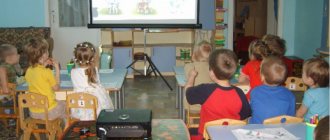What are plans for?
Do not treat plans solely as a reporting document that needs to be maintained just because management requires it. Teacher plans are a working tool that helps in achieving planned goals. A plan drawn up in advance will allow you to use all opportunities for education and avoid haste, mistakes or excessive stress on children. No important task will be missed.
The plan makes it easier for the teacher to work in a group - if every minute of the working day is planned out, there is no need to think about what to do now and what materials will be needed for this. Knowing what you have to do today will make you more focused and calm.
To successfully plan your work, use methodological manuals and recommendations given by the senior educator and methodologist, and take advanced training courses.
What to include in your calendar plan
- List of children.
- Class schedule for the week in accordance with the program and SanPiN:
- for children under 3 years old - no more than 10 lessons of 8-10 minutes each in subgroups of 5-6 people;
- in the younger group (from 3 to 4 years old) - 11 lessons of 15 minutes each;
- in the middle group (from 4 to 5 years old) - 12 lessons of 20 minutes each;
- in the older group (from 5 to 6 years old) - 15 lessons of 25 minutes;
- in the preparatory group (from 6 years old) - 17 lessons of 30 minutes each.
Half of the time should be spent on physical education and health activities.
Planning various activities
It is most convenient to divide the daily plan into three parts - morning, afternoon, evening. And start each of them with routine moments, and then describe in detail the various types of activities.
1. Specially organized classes are a form of education for preschool children. Their goal is the formation of certain skills or knowledge, the diversified development of the child. For such classes there is a clearly defined time and place (according to the schedule).
The teacher’s work plan for each lesson indicates its content, didactic objectives, structure (beginning, course of the lesson and end) and the methodological material used.
2. Joint activities of the teacher with children include individual conversations with each of the children, educational and sports games, exercises for the development of fine motor skills, reading and looking at illustrations, physical activity on the street and in a group, observing nature, labor, artistic creativity, listening to music .
3. Independent activities of children . About 40% of the total time is devoted to it. This is a free activity for children, which they choose according to their interests. The task of a kindergarten teacher is to organize a developmental environment for children, in which each child can choose an activity for themselves: playing board games or role-playing games, building a house or drawing. The teacher can guide the children and intervene when conflicts arise.
Independent activity also includes the formation of hygiene and self-care skills.
What else to consider when drawing up a plan
Planning walks and work between preschool teachers and parents requires special attention.
►Walks usually take place twice a day. They relieve stress and help children regain strength after classes.
Where to start the walk? If there have been active activities before, then they begin with observations of nature, people, and transport. If the classes were calm, then it is better to start the walk with outdoor games. In the senior and preparatory groups, walks can sometimes be replaced by excursions or hikes. Remember to leave some time for children to freely choose their activities.
►The work of educators with parents can take various forms: parent meetings, consultations, thematic exhibitions, conversations, parent participation in the life of the group (including excursions and hikes).
General planning guidelines
- Make a plan together with the second teacher of the group.
- If your group is multi-age, you need a separate plan for each age.
- Consider the general level of development of children, their interests and needs, as well as the individual characteristics of each child.
- Improve calendar plans throughout the year based on the results of observing children in the group and conversations with parents.
- Do not forget about the regularity, consistency and cyclical nature of events.
- Maintain a balance of intellectual, physical and emotional stress. Remember that kindergarten is not a school.
- Ensure the interconnection of all types of activities: learning, play, work.
- To remember to take into account the wishes of specialists working with children, for example, a speech therapist or psychologist, write down individual recommendations in your plan.
- Plan to work with parents.
- Ready-made teaching materials and plans for kindergarten can be used as a basis, but there is no need to completely copy them. Plan your activities yourself, taking into account the characteristics and interests of the children.
- Keep a card index with descriptions of various activities and update it regularly. At any time you can find in it the necessary information to solve your problems.



